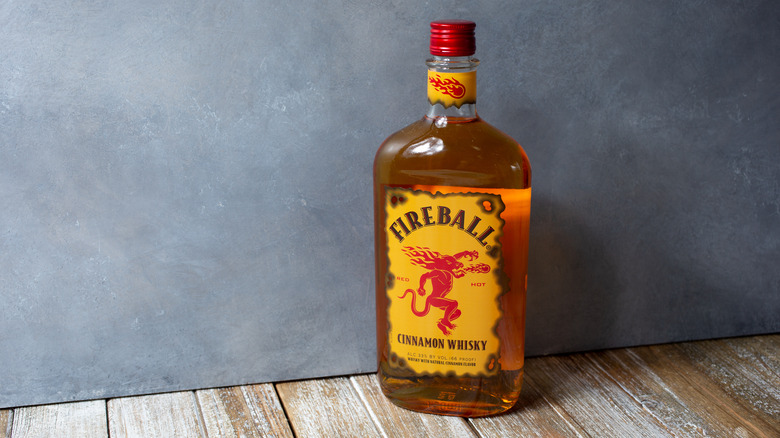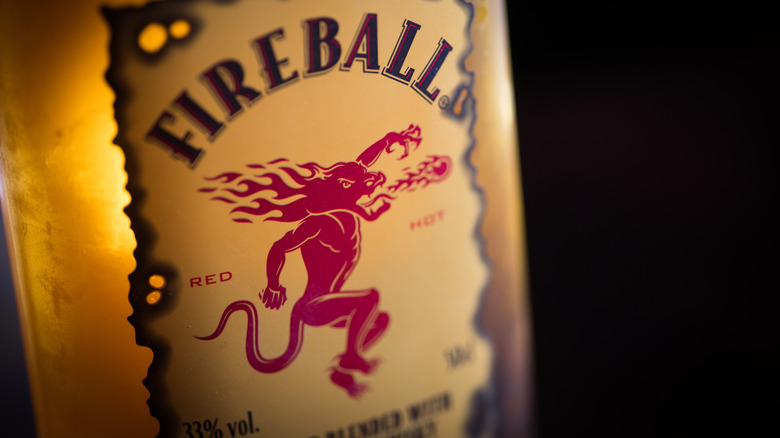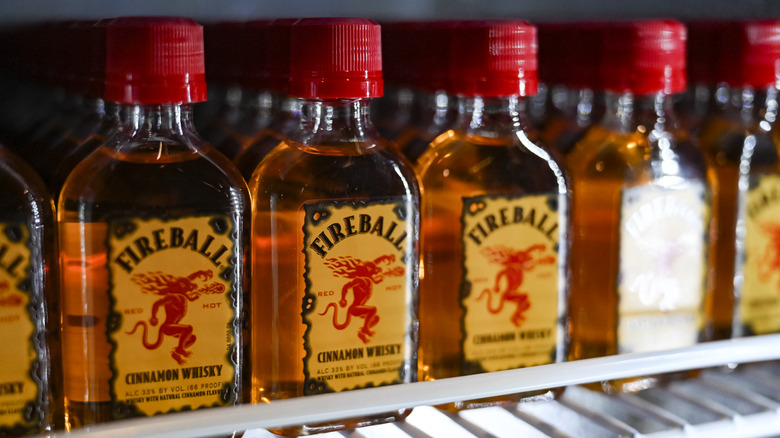Fireball's Roots Might Actually Trace Back To Canada
If you have any geographical association with Fireball, the sweetened, cinnamon-flavored whisky drink, there's a good chance it's your college campus (or possibly Miami, thanks to the Pitbull song of the same name). But it turns out that the spicy spirit may actually hail from the Great White North — at least, according to legend.
But first, we should clarify one thing: Fireball isn't technically whisky, as far as the law is concerned. According to U.S. government regulatory bodies, for a spirit to legally be considered whisky, it needs to be between 40 and 95% alcohol by volume (ABV). Fireball falls just under that range at 33% ABV, so technically, it's a distilled spirit. The slightly lower alcohol content, along with the powerful spicy-sweet cinnamon flavor, is probably what makes it so approachable for less-experienced drinkers.
That combination of cinnamon, sugar, and whisky was supposedly first concocted by a Canadian bartender trying to beat the deep chill of a Northern winter. But regardless of how it actually came together, we definitely have Canada to thank for the spirit that famously "tastes like heaven, burns like hell."
Canada's coldest winter
According to Sazerac, the company that currently owns Fireball, the legend goes that the spirit originated in Canada in the mid-1980s. It was the coldest winter Canadians had experienced up to that point, and a bartender was attempting to concoct a treatment for frostbite. While Fireball may not actually have any medicinal purposes, the taste was a hit — and it'll certainly help warm you up.
The story of the anonymous bartender may or may not be pure mythology, but in any case, the spirit's Canadian origins are verifiable. It's made with Canadian whisky, and for the first 20 or so years it existed, it was only available in Canada. The drink was originally part of the Dr. McGillicuddy's line of flavored spirits — owned by beverage manufacturer Seagram — until Sazerac bought it in 1989. It took until the early aughts, however, for it to really break into the U.S. market, probably aided by its 2007 rebrand from Dr. McGillicuddy's Fireball Whiskey to simply Fireball Cinnamon Whiskey. Throughout the 2010s, it enjoyed a surge in popularity thanks in large part to on-the-ground marketing efforts. In 2021, Statista reported that Fireball sold 6.8 million 9-liter cases in the U.S. You could say it's caught on like ... wildfire.
Canada x USA = Fireball
We'll likely never know if Fireball was first inspired by a chilly bartender's concoction, or if it was developed in a test kitchen or laboratory somewhere up north. And though we do know it hails from the great country of Canada, a major whisky-producing country, the spirit does have some U.S.A. in its DNA after all — the whisky used to make it is aged in used American bourbon barrels.
It's unlikely that Fireball will cure anyone's frostbite, but the warm taste and sensation still make it a cold-weather favorite. It's commonly taken as a shot since it has less of an ethanol burn than standard whiskies do, but you can always double the warming factor by using it in a hot toddy or for spiking a steaming mug of apple cider. If you just can't get enough of that sweet-hot cinnamon taste, you can even try adding it to your baked goods (yes, really). No matter how you consume it, it's a surefire (ha) way to fight the cold.


